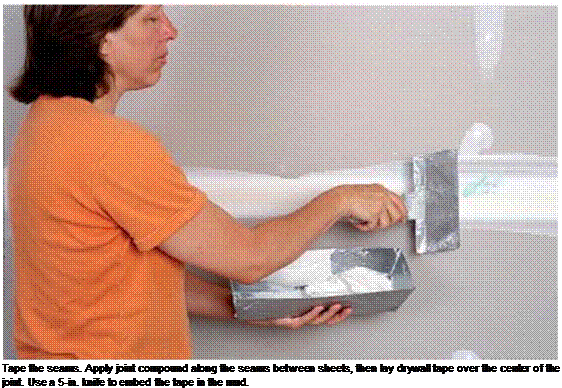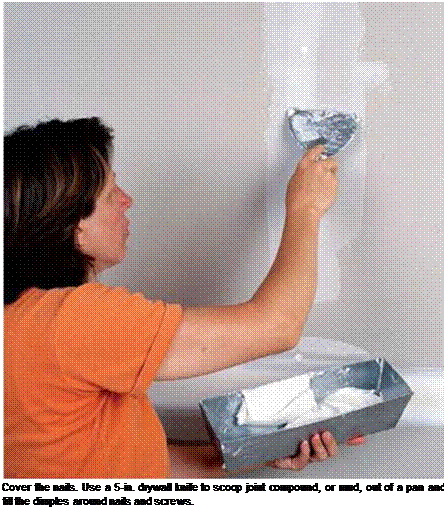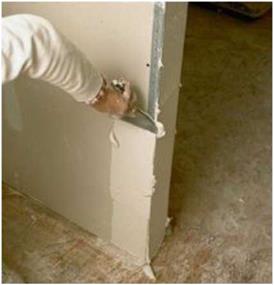Do the prep work
Before you start taping and mudding, make sure that all fasteners are below the surface of the drywall. You can do this by running your hand or a wide drywall knife over the fasteners in the walls and ceiling. If any fasteners are proud of the surface, they will show when you apply the first coat of mud.
You may need to do a bit of repair work around electrical-outlet boxes. If the fit around these boxes is sloppy, use a fast-setting (as opposed to a slow-drying) joint compound that’s available at supply stores. Mix a batch and fill the gaps with a small putty knife. Place small pieces of drywall tape over the mud and apply a smooth coat on top of the tape.
If the gaps are quite narrow, use latex caulk to seal around them.
COMPOUND AND TAPE. Part of your preparation work is making sure you have the right supplies on hand. Joint compound is normally used as the bed for tape. If you’re new to drywall work, you’re better off buying
premixed joint compound that is ready to apply. Topping compound is applied over joint compound; it has a finer, creamier consistency so that it can be smoothed out nicely. It’s available in premixed and powdered forms. You’ll also need enough tape to cover all the joints between panels, including the inside corners. Buy about 400 ft. of tape for every 1,000 sq. ft. of drywall.
The long edges of drywall panels are tapered, allowing the seams between adjacent panels to be filled with joint compound and taped to create a level surface. Begin by using a 5-in. knife to apply mud about /4 in. thick along the entire seam. Roll out the tape from corner to corner, center it on the joint, press it lightly in place, and then pull it tight and straight.
Once the tape is in place, drag the knife over the top, applying enough pressure to embed the tape as you go (see the photo below). Make sure the tape is flat, wrinkle-free, and embedded in about /4 in. of mud. Be careful not to create
 Clean up as you IIP go. When left lying around, scrap pieces of drywall crumble easily, making a paper and powder mess that can be tracked all over a job site. Avoid this by cleaning up drywall as you go. Stack usable pieces so they are easily accessible.
Clean up as you IIP go. When left lying around, scrap pieces of drywall crumble easily, making a paper and powder mess that can be tracked all over a job site. Avoid this by cleaning up drywall as you go. Stack usable pieces so they are easily accessible.

mud buildup in the corners. Clean any excess compound from along the edges of the tape with your knife.
Inside corners and wall-ceiling joints are taped a bit differently than flat joints in a ceiling or wall. Use a 4-in. or 5-in. knife to apply an l/S-in.- thick layer of joint compound on each edge of the corner. Next, fold the tape at the crease and press it into the corner, flattening it as you go. Working on one edge at a time, press the tape against the drywall and into the mud with the taping knife.
Outside corners covered with corner bead are easier to do (see the photo below). Using the same 4-in. or 5-in. knife, press mud along the length of the corner. The outside edge of the corner bead acts as a guide for your knife as you pull off excess mud.
The ends of a drywall sheet are not tapered like the edges are. For this reason, you should use less mud to cover the tape at the butt joints, where the ends of adjoining sheets meet. Otherwise, you can create an obvious bump in the wall. Cover the tape lightly with mud, and feather the edges away from the center of the joint so any bumps that result will be slight.
In hot, dry climates, joint-compound applications dry rapidly. Mud that dries too fast may not bond well and can crack. Try mudding a couple of joints in a room and then applying
|
|
tape right away, rather than mudding every joint first. You may need to close up the house to retain moisture and create a slower drying time. You can also use an easy-to-sand setting compound that hardens with little shrinkage and is basically unaffected by hot, dry conditions.
It’s a different story in cold and humid areas. Builders in those regions often have to close up the house, turn up the heat, and open the windows a bit to let out moisture. Portable propane heaters work well to help things dry, but they exhaust additional moisture into the air. If you’re using them, leave a window open so moist air can escape. Kerosene heaters also work well, but it may take a while for the smell to leave the house.
Mud the corner beads. Apply joint compound generously along each side of a corner bead. To level off the compound, run the taping knife over the rounded outside edge of the bead. [Photo by Charles Miller, courtesy Fine Homebuilding magazine © The Taunton Press, Inc.]







Leave a reply